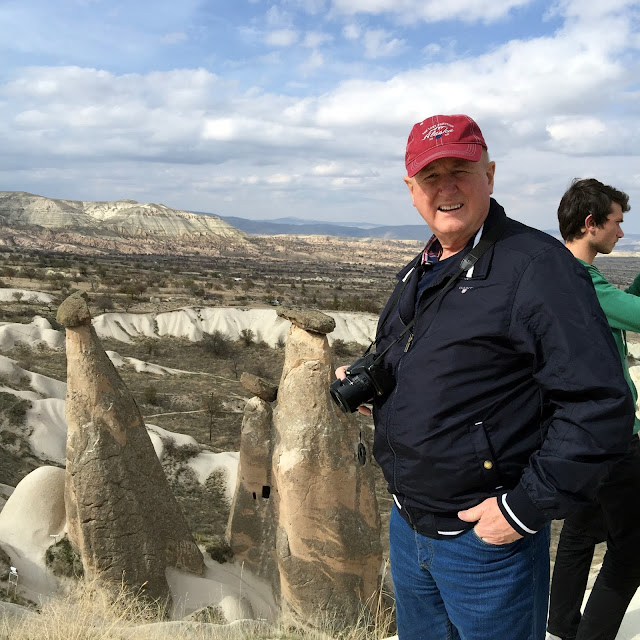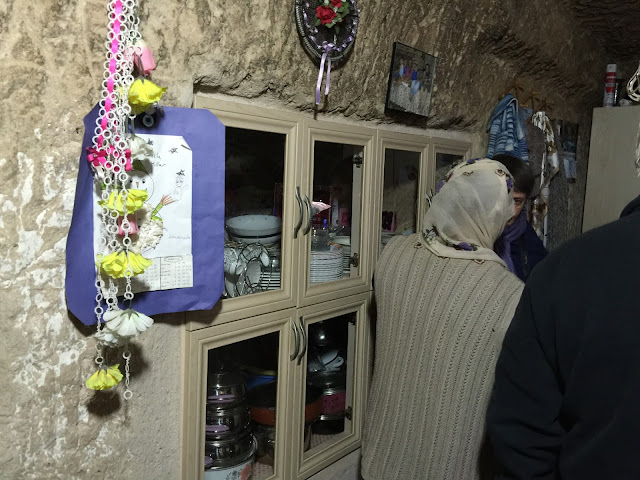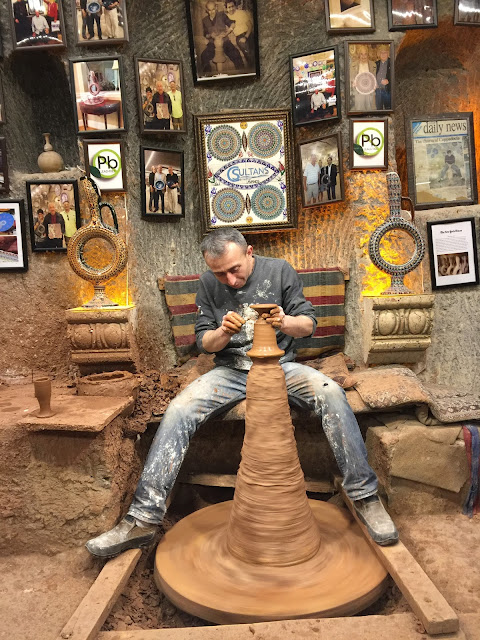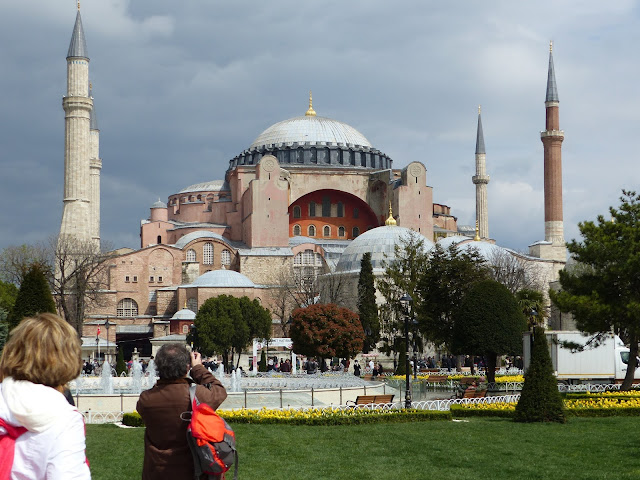Hal and I had the wonderful experience of going on a travel study tour to Turkey and Greece with our long time friends - Becky and Steve Smith. The trip was called: "The Travels of Paul and the Apostles". Our first destination was the fascinating city of Istanbul, Turkey.
Istanbul
We spent 2 very full days in this ancient city founded in 660 BC and was once known as Constantinople and Byzantium.
Harbiye Mosque
Our first stop was at a mosque.
Our Turkish guide, Tyler, is in the center of this photo. Tyler was very knowledgeable about Istanbul and all of the sites we visited in Turkey.
We were each given receivers and used our earphones to hear all of the information given by our guide. This mosque was beautiful and it was interesting to learn more about the Muslim religion.
We all removed our shoes before entering and the women covered their heads.
Spice Market
This huge bazaar was our next stop. It featured spices, dried fruit, nuts, candy and many other items.
I have never seen so many different spices in my life!
Turkey certainly represents another culture, very different from our own. I loved all of the sights, smells and sounds in this market.
You have to admire his sense of balance!
Boat ride on the Bosporus
Istanbul is a unique city built on 2 continents - Europe and Asia - The Bosporus Strait makes the separation. Most of the businesses and commerce are on the European side of the city and most of the population live on the Asian side. Bridges join the city.
We boarded a boat for a tour of the Bosporus.
The natural harbor is called The Golden Horn. You can see the famous Hagai Sophia (originally a church, later a mosque and now a museum) and the minarets of other mosques in the background.
Summer homes of the wealthy line the strait and represent some of the most expensive real estate in the world.
One of the bridges joining the two continents of Istanbul
We could see the remains of the ancient city wall and fortresses.
A closer look at the Hagai Sophia from our boat
The Sultanahmet Square
Next we visited and explored many museums and sites on this famous square.
Becky and Steve Smith
Remains of the Hippodrome of ancient Byzantium
The Egyptian obelisk and the Column of Constantine
The bronze sculpture of the entwined serpents from Delphi
A unique honey and nut shop in the nearby Binbirdirek area
A Turkish woman making flat bread
We took a break and stopped for some hot chocolate and to warm up in a nearby Starbucks.
Istanbul - crossroad of the world
Alemdar Bascilica Cistern
This was our last site on a very full day of sightseeing and we were all tired and jet lagged. We treked down, then up the 75 steps, but the climb was well worth our effort! This was truly an amazing place!!
This underground cistern is the largest of several ancient cisterns that lie beneath the city and were built in the 6th century BC. This cistern is cathedral sized and capable of holding 100,000 tons of water. The ceiling is supported by marble pillars.
Built by 7,000 slaves - WOW that represents a lot of manhours!
Two of the pillars are made of reused blocks of marble that were carved with the face of Medusa - one on her side and one upside down.
This cistern was used as a location for the 1963 James Bond film - From Russia With Love.
The shallow waters are now filled with fish - carp, I believe.
Kucuksu Palace
Our second day in Istanbul began with a tour of the Kucuksu Palace which was used by the Ottoman Sultans as a summer residence and for short stays during country excursions and hunting trips.
One of the lavishly decorated rooms inside the palace.
This beautiful palace is on the Bosporous.
Sultanahmet Square
We then returned to the Sultanahmet Square for a closer look at the Blue Mosque, the Hagai Sophia, and the Topkapi Palace and palace grounds.
The Blue Mosque
This beautiful mosque is named for the many blue tiles that adorn the walls. Built in the 1600's by the Sultan Ahmet I, it has 6 minarets that are used 5 times a day for the call to prayer.
This photo shows the Alemdar which is the washing of the hands, feet and face prior to entering the mosque for prayers and worship.
These photos show the gorgeous ceiling of the mosque.
Beautiful interior!
You can see some of the blue tile work on the walls.
The Hagai Sophia
This magnificent structure was a former Greek Orthodox, then Catholic Cathedral (537 - 1453 AD), later, an imperial mosque (1453 - 1935) and now serves as a museum in Istanbul on Sultanahmet Square overlooking the Bosporus.
It is impressive in its size and beauty.
With its rich and mixed history, we found ruins and relics of both Christianity and of the Muslim religion.
Once inside the Hagai Sophia, we enjoyed our first presentation from Michael Wilcox who was the featured guest lecturer for our tour. He was very knowledgeable on many subjects and brought an incredible spirituality to this trip, as he wove Bible scriptures with personal stories and testimony. He told us of the history of this basilica/mosque and tied the Christian history to Revelation 12:2-6; likening the woman travailing at birth to the early Christian church, that struggled to survive and was protected by the Orthodox and Roman Catholic churches as Christianity began to take hold (Rev.12:6). He also told us of the beautiful Paschal (Easter) Sermon given here by St. John Chrysostom (347 - 407 AD). He read to us some of this oft quoted homily that teaches of the love and mercy of our Lord.
If anyone is devout and a lover of God, let them enjoy this beautiful and radiant festival.
- If anyone is a grateful servant, let them, rejoicing, enter into the joy of his Lord.
- If anyone has wearied themselves in fasting, let them now receive recompense.
- If anyone has labored from the first hour, let them today receive the just reward.
- If anyone has come at the third hour, with thanksgiving let them feast.
- If anyone has arrived at the sixth hour, let them have no misgivings; for they shall suffer no loss.
- If anyone has delayed until the ninth hour, let them draw near without hesitation.
- If anyone has arrived even at the eleventh hour, let them not fear on account of tardiness.
- For the Master is gracious and receives the last even as the first; He gives rest to him that comes at the eleventh hour, just as to him who has labored from the first.
-
- He has mercy upon the last and cares for the first; to the one He gives, and to the other He is gracious.
- He both honors the work and praises the intention.
- This homily is presented on Easter Sunday by both the Eastern Orthodox and Eastern Catholic churches and is often interactive with participation of the congregation who all stand.

You can see both the Christianity mosaic of Mary & the infant Christ and the Islamic writings from the Koran represented in this beautiful museum.
A lovely mosaic of the Savior
Muslims, Christians and people of all faiths visit this huge attraction which hosts over 3 million visitors a year.
The Hagai Sophia is famous for its Byzantine architecture and its massive dome. This structure has served as the inspiration for many Ottoman mosques.
Topkapi Palace Museum
Also on Sultanahmet Square is the Topkapi Palace and surrounding gardens and structures. This was the administrative center
for nearly 400 years, for the Ottoman Empire.
Palace Gardens
The trees in the background of this photo are cedars of Lebanon - known for their use in the construction of the Temple of Solomon.
Michael's second lecture was given on the palace grounds. Once again his message was informative and spiritual. He is a great speaker and storyteller.
Michael Wilcox
After Michael's presentation, we took a break for lunch at the Palace Cafe overlooking the Bosporus.
We ate traditional Turkish foods (lentil soup, rolls and a variety of Turkish desserts) and enjoyed the awesome view!
That evening we ate at an Italian restaurant near our hotel. This post had to have at least 1 "selfie" and this is it!!


















































































